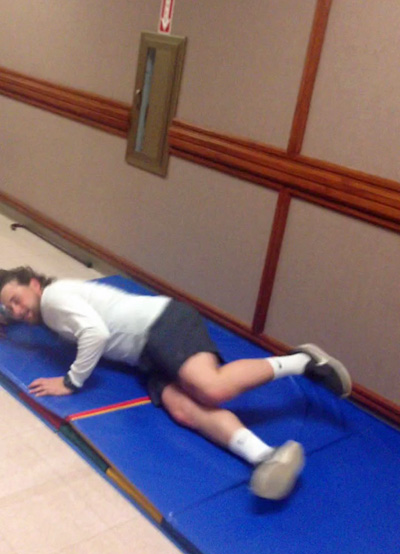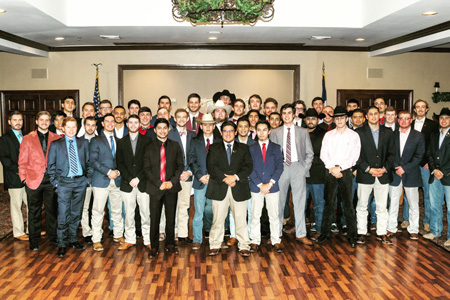They Fell for Us, Over and Over Again!
 "Learning is not attained by chance, it must be sought for with ardor and attended to with diligence."
"Learning is not attained by chance, it must be sought for with ardor and attended to with diligence."
- Abigail Adams
When we developed the MyNotifi fall detection device, it wasn’t all at once. We knew it was going to be a process of learning, creating and innovating. First, we created an algorithm that could learn and therefore, help guide our development. Then we gave it a large number of experiences and data points to learn from. This required some hardy volunteers to help us collect data on how people fall by, well, falling for us.
After the engineers were done designing the components and electronics, our team of expert researchers developed the criteria for these fall trials. But, we still needed to find those individuals to “take the fall” for us. Repeatedly. Who would do such a thing?
Turns out when we needed to learn, we could turn to Angelo State University, in San Angelo, Texas, where our company is headquartered. It was there that we recruited many adventurous Physical Therapy faculty and Ph.D. students who were game to put on some padding and start falling.
Of course with any fall-detection system, It’s critical to accurately detect when a person falls. However, it’s equally important for a fall detection system to accurately know when a person did not fall to prevent false positives. What happens when someone drops a contact lense on the floor and drops to their knees to search for it? Or perhaps when an exhausted person sits down a bit too heavily in an easy chair in front of the TV?
These are all common activities for people in their daily lives, and the device needed to recognize them as normal, non-falling behavior. Were you out in the garden, digging holes to plant some flowers? That’s normal daily living too, and definitely doesn’t count as falling. Neither is emptying the dishwasher or sweeping the floor, even though there could be a lot of vertical or horizontal continuous motion with either. Many of our volunteers spent hours doing normal activities while wearing early draft versions of the device, helping to train the algorithm to recognize what is a normal, non-falling activity. And then, our volunteers spent hours actually falling–in every way you can imagine. In fact, we consulted experts on falling who helped our volunteers fall in all the surprising number of ways that people actually do fall.
The testing was conducted by a professional research team, and operated through the university’s Institutional Review Board, which ascertains that the research meets their rigorous scientific standards. And no students were harmed in the study. Unlike people in the real world, our testers were protected from injury.
We used as many as 30-40 testers per session, with multiple rounds every few weeks. We used the results to train the algorithm. We blocked off a wide hallway, so students could throw themselves through the air, simulating tripping. They landed on double-stacked mats, then got up to fall again. Some students used canes and walkers. We tested falling when getting out of a chair and falling when getting out of bed. We know how people really fall, and that’s what we simulated. We even did rounds of testing that were slow, with no flailing arms, as if the person simply dropped–another common form of falling if you’re dizzy or faint.
“This was unlike any test they’d ever taken before,” said Dr. Jackie Brown, of Angelo State University, where much of the research is being done.
After each round of testing, the results were used to update the algorithm, each time, each round bringing the accuracy level up, and the rate of false positives down, until the MyNotifi device was ready for primetime.

So how does MyNotifi work? You wear it on your wrist. If the device detects that you’ve fallen, it sends a notification to a list of friends, neighbors or family that you’ve chosen. You can also choose to have a 24/7 call center receive your alerts. But before it sends out the alert, it first asks you whether you need help. If it was a minor fall, or a rare false reading, you simply respond that you don’t need help, and no alert goes out. If you respond yes, or if you don’t respond at all, the alert will be sent out to your list. There’s one other situation MyNotifi can handle. What if you haven’t fallen, but you need help anyway?
There’s a TAP for that!
Pehaps for some reason you find you can’t get out of a chair, or you’re seated on the ground and can’t get up. Regardless of the reason, if you need help, you can vigorously tap your MyNotifi device, which sends an alert to your list of friends that you need assistance. You don’t even need to fall to get help or support.
In addition to fall detection, MyNotifi helps with fall prevention. The MyNotifi app comes pre-set with 38 exercises approved by the American Therapy Association (APTA) for strength and range-of-motion enhancement, commonly used in physical therapy today. These are the types of exercises that help with fall prevention. The app guides you through the exercises, monitoring your reps and your range of motion. Our testers put the device through its paces, testing the accuracy of its measurements, and, once again, making sure that the device knows the difference between exercising and falling.
How did the students do? They had a blast. We fed them pizza, and they enjoyed the opportunity to learn new things, while releasing some stress! And they kept coming back. Thanks to them, and to all the engineers and researchers involved in developing MyNotifi, we can help people everywhere be safer from falls.


Comments (0)
Write a comment
Rating: Bad Good
Enter the code in the box below: